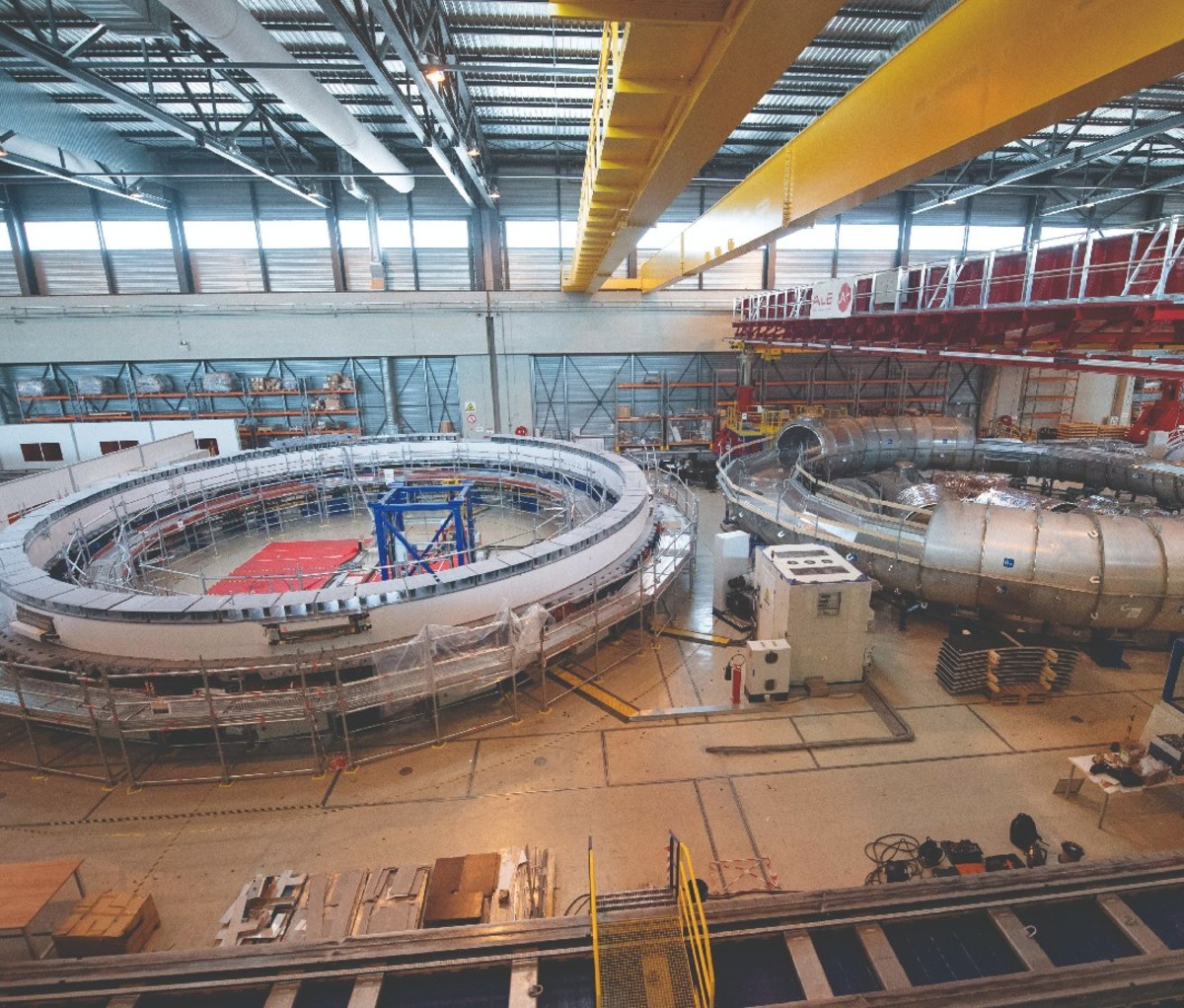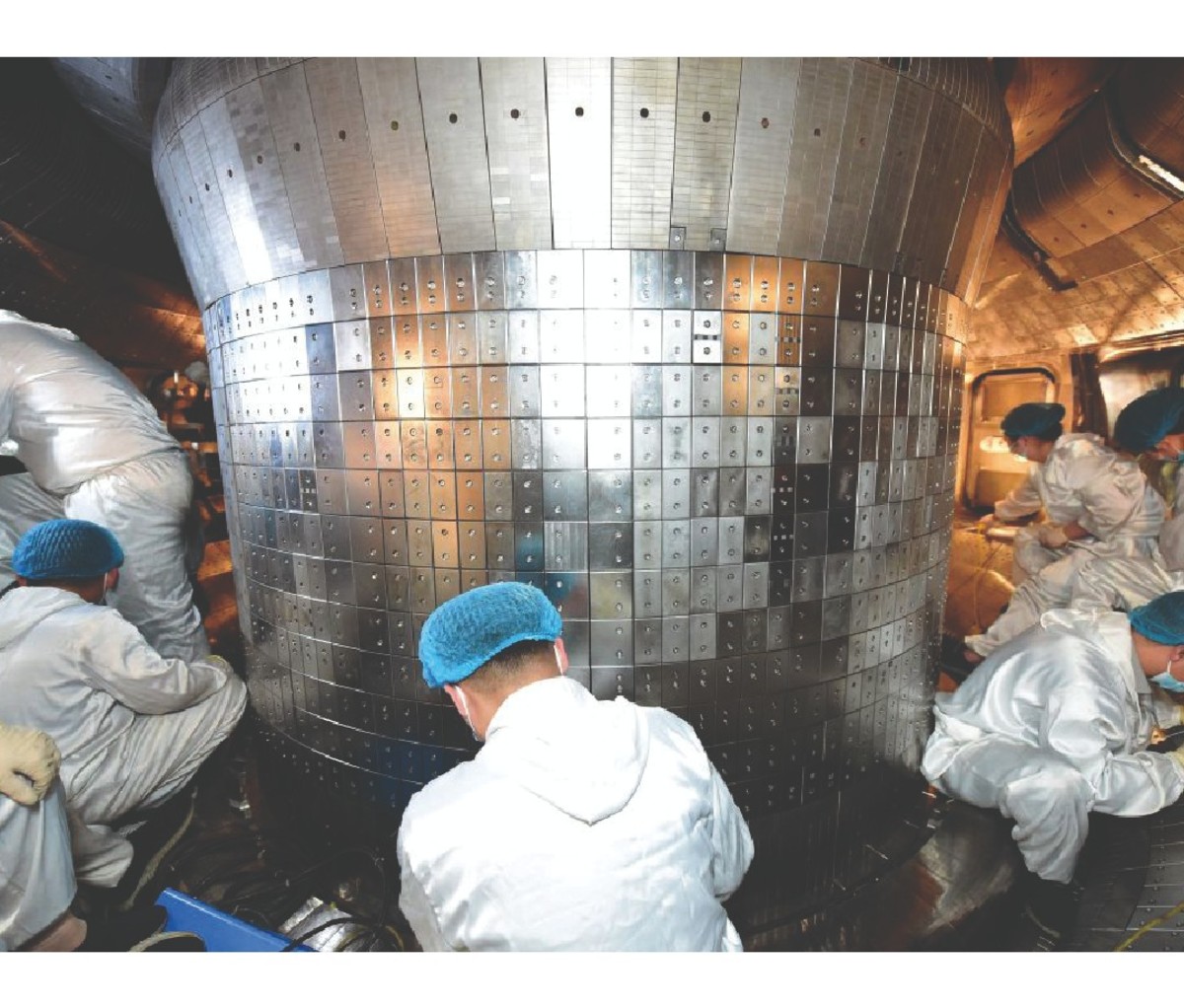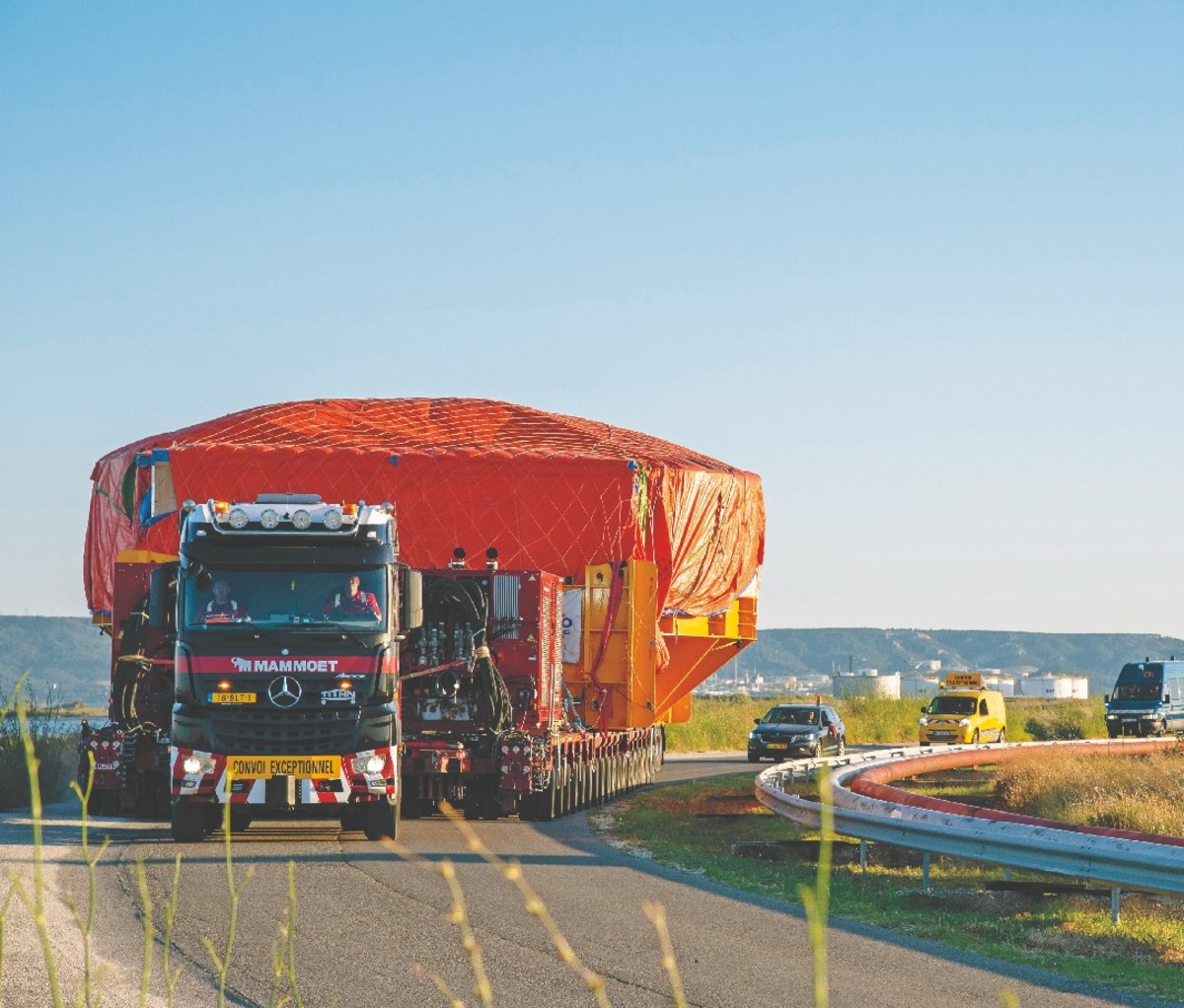Nuclear fusion has been a fantasy for decades. But recent breakthroughs signal the holy grail of clean energy could finally be close to reality. Who’ll get there first?
21 seconds.
On May 30, 2021, a team of 300 nuclear scientists and engineers at the EAST (Experimental Advanced Superconducting Tokamak) reactor at China’s Hefei Institutes of Physical Science, about halfway between Shanghai and Wuhan, accomplish something human beings have never done before. A new world record is established.
30 seconds.
They’ve created a small “artificial sun” that burns hotter—120 million degrees Celsius or 216 million degrees Fahrenheit, 15 times hotter than the core of our actual Sun—than any temperature previously reached on Earth.
40 seconds.
Now the question is how long they can keep the reaction going.
50 seconds.
Superheated hydrogen plasma twists as it pushes around a circular path inside the reactor’s doughnut-shaped metal tube.
60 seconds.
A series of superconducting toroidal and poloidal magnetic coils—an innovation unique to EAST—keeps the streams of superheated plasma from expanding outward or collapsing inward, whipping around the core.

70 seconds.
Crucially, the powerful magnetic field also contains the plasma’s extreme temperatures, which would instantaneously melt any natural or man-made structure that attempted to hold it.
80 seconds.
At these extreme temperatures, hydrogen ions in the plasma smash into each other, fusing together to create helium and giving off enough energy that could facilitate a self-sustaining reaction.
90 seconds.
The team stands behind their computers in a room not unlike NASA’s Mission Control, holding their collective breaths as they watch a reaction now almost five times as long as anyone has created before.
101 seconds.
And just like that the reaction collapses, like every attempt before it by every experimental fusion reactor on Earth. But that was expected. As incredible as the EAST team’s achievement is, the going joke is that nuclear fusion is mere decades away—and always will be.
Upwards to the vanguard
In principle, nuclear fusion is the same process that powers our Sun. Atoms (in the case of our Sun and most fusion reactors, hydrogen atoms) are pushed together with enough speed to overcome the natural repellent force of their protons, fusing them together. With hydrogen, this fusion produces larger atoms of harmless helium—as opposed to the more familiar technology of nuclear fission we currently use, which splits much heavier atoms like uranium or plutonium and creates problematic amounts of radioactive waste.
On Earth, scientists most often use the hydrogen isotope deuterium (H isotope) as the base fuel for fusion reactions, which works better than basic hydrogen in lab conditions. Deuterium (where the single proton in the atom’s nucleus is joined by a neutron) is so common in nature that a single gallon of seawater theoretically could produce the same energy as 300 gallons of gasoline. As with nuclear fission, fusion also produces a massive amount of energy that can then be harnessed and converted into electricity, although this is still often handled by using the resulting energy to heat water into steam to turn turbines, an inefficient process not far evolved beyond the centuries-old technology of waterwheels and windmills.
Beyond the absence of greenhouse gas emissions or horrendously dangerous waste products, fusion also has a pronounced advantage over nuclear fission when it comes to safety. In a standard nuclear reactor, a mishap always has the possibility of unleashing an out-of-control reaction or meltdown—nuclear power experts say this scenario is highly unlikely, but we only have to look at Chernobyl for a lesson in human hubris regarding forces beyond our control. In a fusion reactor, a mishap results in the immediate collapse of the reaction itself—no radiation leak, no disaster.
The difficulty in making nuclear fusion viable is, fundamentally, that a reactor on Earth simply can’t replicate the core of the Sun. Whereas the Sun’s massive gravitational force is strong enough to force large numbers of hydrogen atoms to fuse together, Earth-bound reactors require much higher temperatures to produce the same result, and on a much smaller scale. These higher temperatures in turn require a massive amount of energy to produce—and no experiment since the first fusion efforts began in the 1950s has yet to come close to the so-called “break-even point,” where the amount of energy it takes to start and sustain the reaction is equal to the energy it generates, which is still far from a level of efficiency that’d make the technology economically viable.
“The breakthrough is significant progress, but the ultimate goal should be keeping the temperature at a stable level for a long time,” says EAST physicist Li Miao of China’s Southern University of Science and Technology.
But as the team at EAST proved this year—adding to their accolades, they were also able to reach 160 million degrees Celsius for 20 seconds—we’re moving in the right direction. Quickly.

Most expensive science experiment in history
While the Chinese team at EAST was celebrating its breakthrough, on the opposite side of the globe a specialized 28-axle flatbed truck was slowly making its way from Southern California to Houston, traveling only at night to avoid traffic, carrying a key part of what could be the closest step yet to sustainable, efficient fusion. The cargo was the first of seven pieces that, after it’s shipped to the under-construction ITER reactor in southern France and assembled there in its core, will make up a massive magnet called the central solenoid.
The largest magnet on Earth, ITER’s central solenoid will be as tall as a six-story building. It will weigh over a thousand tons (requiring a special reinforced road to be built just to bring the pieces to the facility), contain 160 miles of coiled niobium-tin superconductors and produce a magnetic force strong enough to lift an aircraft carrier six feet out of the water—a force 280,000 times stronger than the Earth’s own magnetic field, requiring a structure strong enough to withstand a force twice the liftoff thrust of the Space Shuttle.
Ten years in the making, the central solenoid is one of America’s largest contributions to ITER, the International Thermonuclear Experimental Reactor, a collaborative scientific effort between countries as wide-ranging in national interests as the United States, Russia, China, India, Japan, South Korea, the U.K. and the European Union. Although several of these countries are geopolitical rivals, they share a desperate need for a new source of reliable, unlimited, environmentally friendly energy that doesn’t rely on other countries to supply. The project is well beyond schedule and stupendously over budget. With an estimated construction cost of $45 to $65 billion, ITER is the most expensive science experiment in human history.
“The ITER project is also the most complex scientific collaboration in history,” says Dr. Bernard Bigot, director-general of the ITER Organization. “Very challenging, first-of-a-kind components are being manufactured on three continents over a nearly 10-year period. Without this global participation, ITER would not have been possible; but as a combined effort, each team leverages its investment by what it learns from the others.”
Once complete, ITER will be the largest fusion reactor in the world by far, able to produce a much larger reaction than EAST (or any other fusion reactor on Earth up to now) with 10 times as much plasma, theoretically reaching higher temperatures for a longer period of time—perhaps even beyond the break-even point. ITER’s goal is to produce 500 megawatts from an investment of only 50 megawatts.
Although ITER is purely a research facility, with no ability to channel any energy produced into the electric grid, the goal is to test and perfect various aspects of reactor technology that can then be utilized by future functional fusion reactors in locations around the world. China’s record-breaking EAST effort is actually testing technology and methods to be used on a larger scale at ITER.
If all goes according to plan with the piecemeal shipment of the central solenoid, ITER is expected to reach operational status and generate its first plasma reaction by 2026.

Locked in heated battle
Although ITER represents the basket into which the world’s leading scientific powers have put their most expensive Fabergé eggs, several smaller efforts are also showing promise—with a much more accessible price tag.
Funded by Jeff Bezos, Canadian start-up General Fusion announced last summer it’s breaking ground on a fusion reactor at the UK Atomic Energy Authority’s site near Oxford. General Fusion’s approach is slightly different than ITER or EAST’s. Utilizing technology developed by U.S. and Russian militaries, its reactor will spin molten lithium and lead at high speed while pistons push it in from the outside, creating a sphere with a cavity in the center. Superheated hydrogen, contained by magnetic fields, will then be injected into the cavity to create the fusion reaction. This will then transmit heat through the molten metal to surrounding water, which will be converted to steam to drive turbines and create electricity.
“To re-create a piece of the Sun on Earth, as you can imagine, is very, very challenging,” says General Fusion CEO Christofer Mowry. General Fusion’s goal isn’t to generate a lot of clean electricity just yet, but to test different methods and show the world that the technology works at an accessible level.
“That’s really opened the door not just to being able to make fusion work but to make it work in a practical way,” says Mowry. “You can think about it like building an engine and a transmission and a suspension system of a car, and now finally putting those pieces together and showing you can drive it down the road.” General Fusion expects to be up and running by 2025.
But significant advancements may come even sooner. Lost in the hubbub over EAST’s breakthrough was a small but important milestone reached less than a month later by Helion Energy in Everett, WA. On June 22, its smaller Trenta reactor passed a temperature of 100 million degrees Celsius, making Helion the first private company to reach the mark required to enable a viable commercial fusion power plant.
“These achievements represent breakthroughs with major implications for how the world meets its expanding future electricity needs, while dramatically reducing climate impact on a relevant timescale,” says Helion Energy founder and CEO David Kirtley, a onetime Navy brat who earned degrees in nuclear and aerospace engineering from the University of Michigan and has held fellowships with NASA and the National Science Foundation. Under his leadership, Helion has won multiple future clean energy pitch competitions and funding from the Department of Energy and Y Combinator.
Compared with multinational efforts, Helion’s approach uses a much smaller and simpler non-ignition pulsed fusion system that’s designed to recover electricity directly, rather than inefficiently heating water to steam to turn turbines. Although it doesn’t have the high profile of ITER and EAST, if it proves successful in sustaining a longer fusion reaction, Helion’s method could make the technology much more viable.
The good of all mankind
Add to these efforts several other promising recent advances in the U.S., U.K., South Korea and other countries, and for the first time in history we have a scenario in which teams around the world are finding success working on the same problem with markedly different approaches.
In many ways this method of scientific competition between different groups, in which they also share breakthrough advances, holds the best hope for eventual success. Much like the competing teams working on the atomic bomb or the U.S. and Russia’s space race, individual advances are usually only part of the puzzle. The eventual solution will likely cobble the best elements from different approaches. For something as huge as limitless, clean, safe, cheap energy through nuclear fusion, the price tag so far pales in comparison to the anticipated reward.
Alt Grid: Until nuclear fusion is viable, these energy sources will compete for new power
Solar
- Pros: No emissions. Relatively cheap. Works on small scale. Technology still improving.
- Cons: Costly to install. Dependent on sun. Clouds and enclosed cityscapes make power supply intermittent, requiring expensive and environmentally unfriendly battery systems for rainy days.
- Latest: All-in cost to build, operate and maintain solar power plants has dropped 87 percent since 2010, and is now cheaper than coal or other fossil fuels in China and India, countries that account for 62 percent of the world’s coal-fired power.
Wind
- Pros: Supply effectively limitless. No greenhouse gases. Cheapest renewable energy source.
- Cons: Plentiful but intermittent. Turbines expensive to build, effectively unrecyclable, typically require long transmission lines from wind locations to cities, deadly to birds and bats, eyesore to local residents.
- Latest: Advances have increased generation capacity of wind farms over 50 percent in past 20 years, dropped operational cost from $55 per kilowatt hour in 1980 to 3¢ per kw/h today, making wind even more cost-effective than solar.
Pumped Hydro
- Pros: No emissions, endlessly renewable. Works by storing large volume of water at high elevation then releasing it downhill through turbines to create power.
- Cons: Water pumped uphill from lower source to higher-elevation reservoir requires energy. Costly, labor-intensive to build.
- Latest: Bill Gates–funded Quidnet developing underground spaces where water can be stored under pressure and released to generate power, making pumped storage feasible in flat sites without high/low elevation differences.
Geothermal
- Pros: Limitless, emission-free energy source without intermittency problems—66 percent of Iceland’s energy, which once relied on imported coal, is geothermal.
- Cons: Plants expensive and site-specific, requiring near-surface magma. Like fracking, pumping water into the Earth believed to cause slight increase in earthquakes.
- Latest: Oil industry service players like Halliburton see renewable future in so-called Enhanced Geothermal Systems, which inject water into rock deep in Earth where it’s naturally heated then extracted.
from Men's Journal https://ift.tt/3E6TXB7
via IFTTT






